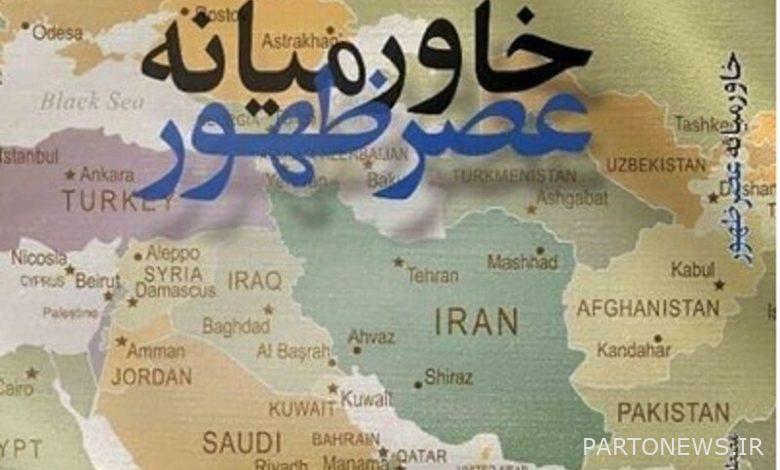The Middle East of the Age of Emergence – IRNA

Throughout history, alongside the right front, there has always been a false current that has used all its power to defeat or reduce the expansion and influence of the right front, and this continuous conflict between right and wrong has continued throughout history and in the end times and Before the emergence of efforts to create a front of monotheism and the formation of universal sovereignty of the divine religions with the focus on Islam and the last divine reserve and savior of humanity, Imam Mahdi (pbuh) will reach its peak. Therefore, it is necessary to be aware of the planning of the false front, and this will not be achieved except by observing the plans, plans, seditions of the enemies in the countries and territories involved in the honorable event of emergence. In fact, the “future of Mahdavi research” by relying on hadith warnings in the Mahdavi heritage and focusing on reports of seditions and social, economic, political, military and security crises, observes the possibility of their occurrence in the “geography of the age of emergence” and pays attention to events. It will be effective in the future.
book introduction
The leading book contains five chapters and a conclusion. In this book, the series of events of the countries of the “Age of Advent” in the triangle of “Kufa, Mecca and Quds” is explained and the long sedition of the Levant with the focus on “Syria”; Future scenario of “Iraq” affecting Shiite security; The role of “Iran” and the groundbreaking revolution; The issue of “Palestine” and the destruction of Israel before or after the emergence; The events of the Al-Falan family have been mentioned in “Saudi Arabia” as the center of the developments of the year of emergence. The book “The Middle East of the Age of Emergence” has been compiled for the general public and can be used for the elite community due to the observance of research rules and scientific standards.
The book includes general sections such as; The necessity of not neglecting the enemy’s planning, The future of Mahdavi research: observation of political, military and security crises, monitoring the events of the influential countries in the triangle of “Mecca, Kufa and Quds” and the events of the “geography of emergence”; The different pieces are “single puzzles”.
The first chapter of the book, entitled Iran, examines Iran’s military confrontation after two stages of claiming the right; The gospel of the “nearness of the resurrection” is given after the Sioux stage. In this article, the role and position of the Iranian revolution before its emergence has been examined with emphasis on the analysis of rights. The main subject is the explanation and analysis of the two stages of “demanding the right” of Iranians before appearing in Mahdavi hadiths; What is the meaning of right? And why the Iranians, despite insisting on obtaining their rights, will demand their rights in the next stages through military power. This article has been compiled with a library method and descriptive-analytical approach and with reference to reliable sources.
The findings of the study indicate: Before the emergence, the revolution and the government will be formed in Iran, which considers its main goal to lay the groundwork for the world government of the Imam of the Age They demand themselves, but the enemy will not give the Iranians their rights (فلا یعطونه). In the next stage, the Iranians understand when the enemies prevent them from seeking their resignation. This time they will demand their right through military power and the enemy will be forced to accept it … In this article, according to authentic hadiths in the sources of the sects, the process of uprising and revolution of the Iranians before the emergence was explained and analyzed. The current that opposes the principle of ground-making has been scientifically debated and the beginning and end of the ground-breaking revolution have been drawn and expressed in a documented and scientific way.
The second chapter of the book, entitled Syria, deals with the role of domestic, regional and international actors in the “Sham sedition” before its emergence. In part of this chapter we read: The sedition of the Levant and Syria before the emergence, the scene of confrontation, differences between the Romans, the current of Ashab (rule) and the current of Abqa (opposition) will be the presence of Turks and Romans, which will eventually bring to power the last “interim ruler” Damascus will be frozen for about 2 years before the emergence of (Sufyani). Sufyani, as the first sure sign of emergence backed by the “Roman, Jewish and Arab” triangle, first took control of Damascus and other areas of Al-Khor Al-Khams, and then, after winning the Kyrgyz war in Deir ez-Zor in eastern Syria, decided to attack. Will have to Iraq. In this paper, with the library method and descriptive-analytical approach and citing valid narrative sources, the sequence of events in the Sham region before emergence will be drawn.
Chapter 3, entitled Iraq, The Scenario of the Disintegration of Iraq; It has examined efforts to establish a Sunni climate and sedition in Shiite areas. The main subject of the leading article is the explanation and political-hadith analysis of “Iraq before the emergence” with Mahdavi’s research perspective. What is the reason for the invasion of Iraq by Sufyan (the interim ruler of the Levant region at the time of the rise)? What will be the reaction of the Shiite Resistance Front and the founders? This article uses a library method and descriptive-analytical approach and citing reliable sources to try to depict the turbulent events in Iraq before that the sedition of “Awf Salmi” in Sunni areas and its impact on the security of Shiite areas in Iraq before its emergence . According to the hadiths and from the perspective of Mahdavi’s research, the scenario for Iraq before its emergence is conceivable: a united but weak Iraq, which, although ruled by the Shiites, is itself divided due to the influence of the opposition and the weakness of the central government. The effect of discord and sedition in Iraq, especially in the Shiite areas of Iraq. Like Mosul and Tikrit, they will dominate, which is in fact the enemy’s attempt to create a “Sunni climate” aimed at dismembering Iraq, as well as severing the Shiite resistance’s communications with the Levant and preventing access to Palestine before its emergence.
The fourth chapter, entitled Saudi Arabia, deals with the dispute and murder in the Alflan dynasty before its emergence. The narrations state that the country of Saudi Arabia, before the advent of Imam Mahdi (as) at the hands of a government opposed to the Ahl al-Bayt (as) and the enemy of the Shiites. The rulers are from the generation of Bani Falan who run the government as a family, but the authority of the Bani Falan government weakens on the eve of its emergence, and a dispute arises between this family until in the last crime of its series of crimes, Zakia’s soul is one of the sure signs of appearing next to the Kaaba. And in the month of Dhu al-Hijjah, they will be martyred fifteen days before the uprising, but with the advent and public uprising of Imam Mahdi (as), the rule of Bani Falan will be destroyed forever.
Palestine is the title of the fifth chapter of this book. The main subject of the leading article is the explanation and analysis of the hadith “The future scenario of Palestine before the emergence” and the fate of the Israeli regime with Mahdavi’s research perspective and also with reference to the contents of Quranic verses and hadiths. Is there any evidence of the weakness, collapse and destruction of Israel “before the rise” in the future legacy of Islamic research? What is the reason for the Western military invasion of Palestine in the final stages of the Sham sedition? What will be the reaction of the Shiite Resistance Front and the Iranians who paved the way for the events in Palestine? In this article, citing credible sources, he tries to depict the turbulent events in Palestine before its emergence, and its impact on the security of Shiite areas in the Middle East will be a clear example.
Chapter Six; Conclusion deals with the future scenario of pre-emergence countries. The constant struggle between right and wrong has always continued throughout history, and in the end times and before the advent of efforts to achieve the aspirations of the prophets and create a front of monotheism to form a world government of divine religions centered on Islam and the last divine reserve and savior of humanity, Imam Mahdi Is reaching its peak.
It is worth mentioning that the book “Middle East of the Age of Emergence” written by Mostafa Amiri has been published by the Ma’aref Publishing Office (the representative body of the Supreme Leader in universities) for the first edition at a price of 65,000 Tomans and in 1000 volumes.
.

